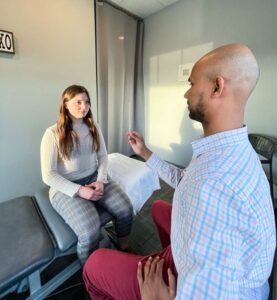
Concussion Management
A concussion is defined as a mild traumatic brain injury caused by either a direct blow to the head or a whiplash related mechanism. The rapid movement of the head causes the brain to move around or twist within the skull. Ultimately, this injury creates temporary chemical changes in the brain and if goes untreated may lead to long term problems. Anyone can sustain a concussion and experience associated symptoms such as, but not limited to, headache, dizziness, confusion, difficulty remembering, fogginess, and sensitivity to light.
A concussion within the first few days and weeks (acute concussion) requires specific assessment and management. When concussion symptoms last longer than 2 weeks in adults and 4 weeks in adolescents it is considered Post Concussion Syndrome. Even though a concussion can be treated at any point within the healing process, we encourage you to be assessed as soon as possible for optimal recovery.
Assessment
Acute Concussions
The initial assessment of a patient with an acute concussion will include a detailed history, tests to ensure that nothing more serious is occurring, and tests for areas that can be affected such as the neck, vestibular system, ocular system and sensory system.
Post Concussion Syndrome
There are many different systems that can cause a patient’s symptoms to linger. An assessment for a patient that has Post Concussion Syndrome includes testing to determine the cause of the lingering symptoms. These areas include the neck, vestibular system, ocular system, sensory integration and exercise intolerance.
Treatment
After the completion of an assessment, a patient will be thoroughly educated to ensure full comprehension of proper management of their concussion at home. During one on one management, the patient can expect more specific treatment to target associated symptoms. This would include vestibular and ocular retraining, manual therapy to focus on cervical soft tissue and exercise training. The therapists will give guidance on returning to daily activities. To ensure a safe return, the patient will be guided through gradual Return to Work, Sport and Learn protocols.





